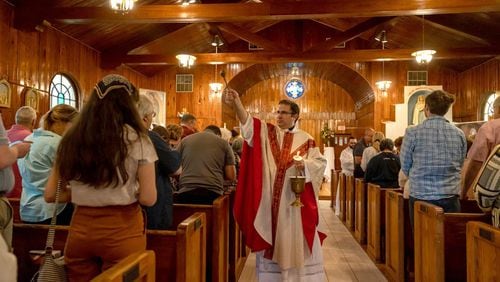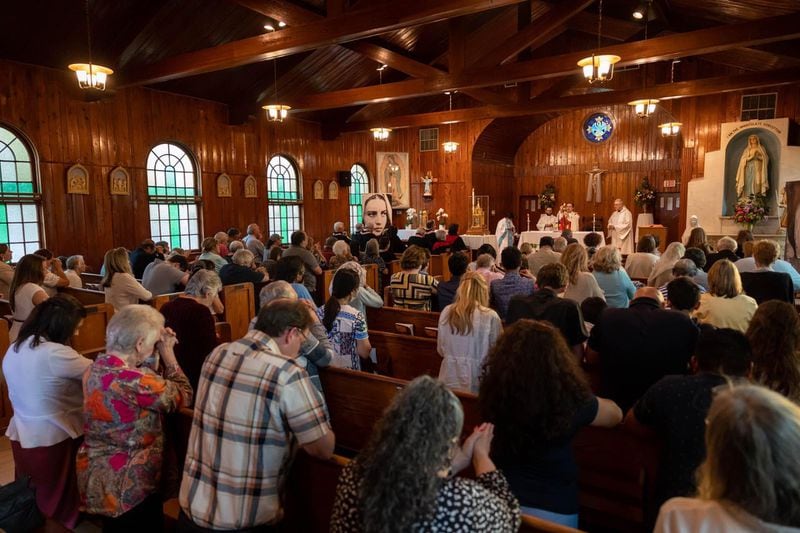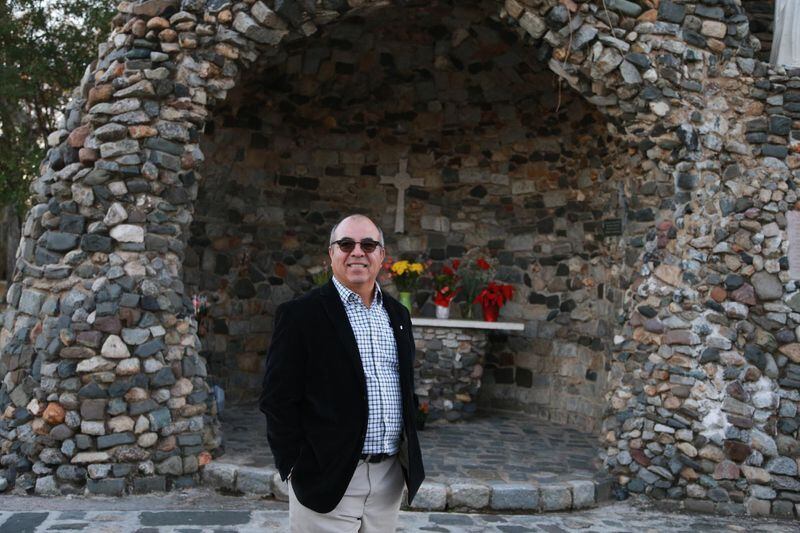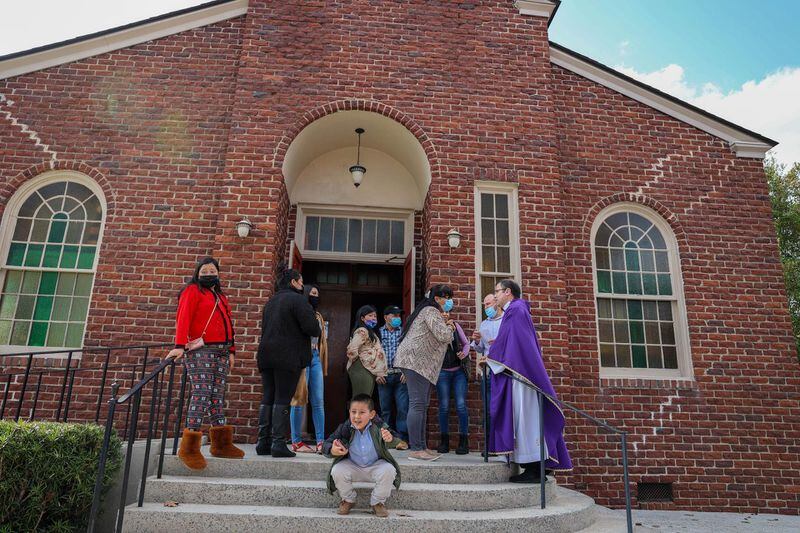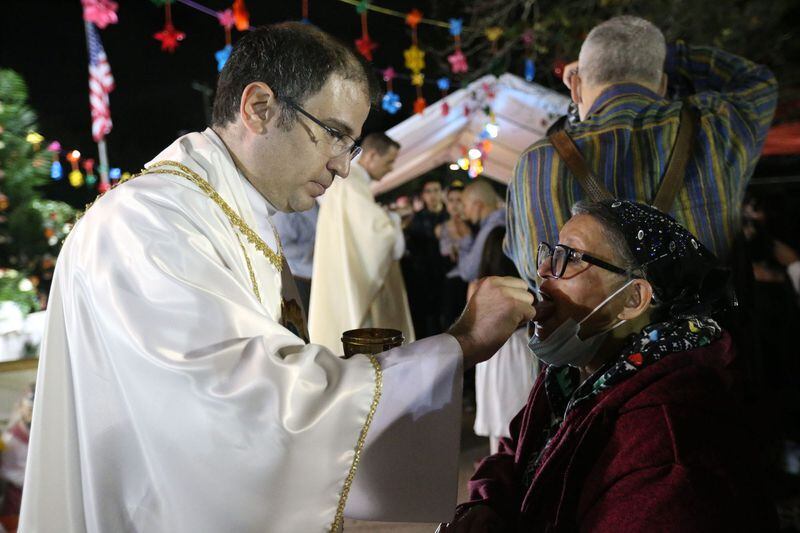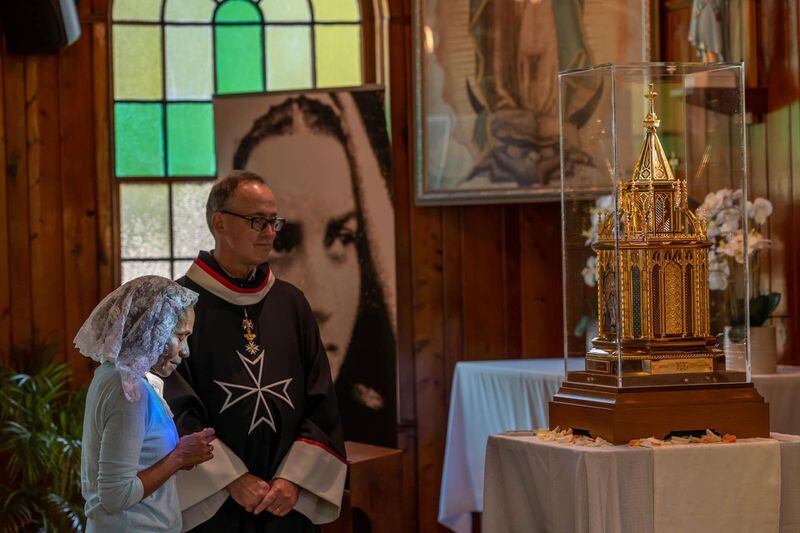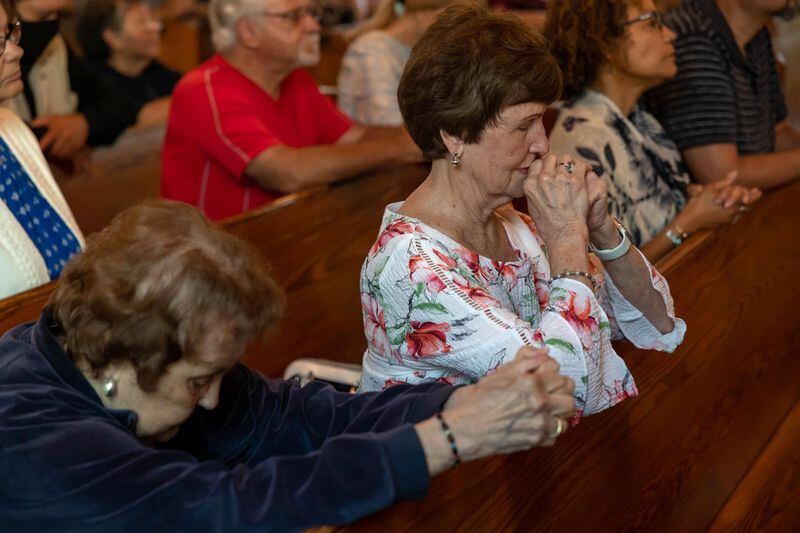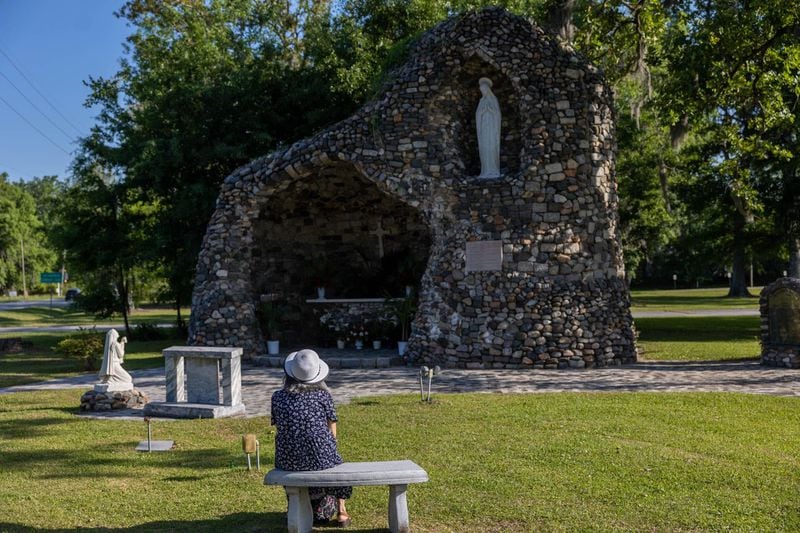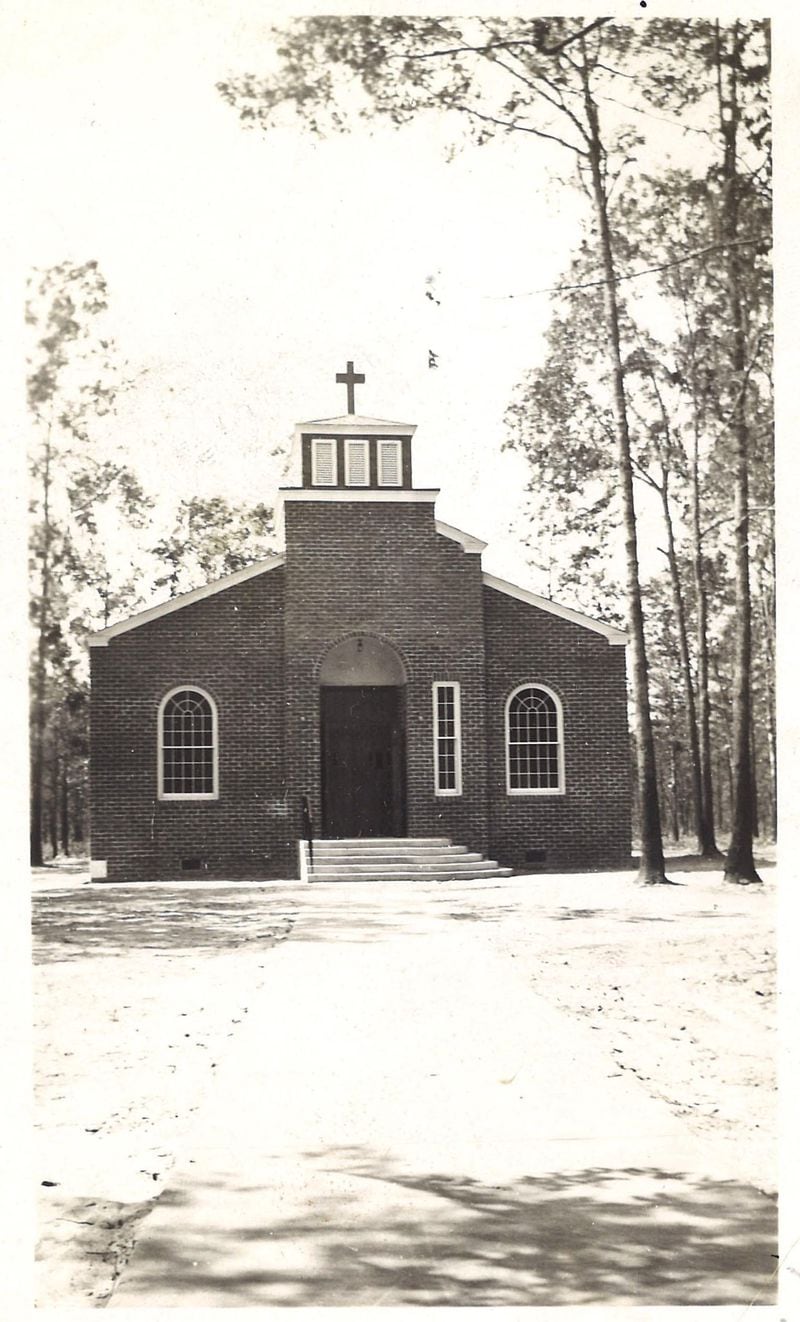From the road, the church and the grotto appear as relics from a quieter time.
The red brick building and stone shrine stand out amidst the bustling industrial streets nearby rumbling with cargo trucks. But the inside of Our Lady of Lourdes tells the story of how this place, founded more than 80 years ago by French-speaking Cajun sugar refinery workers, is still a spiritual anchor for a new community in a rapidly changing area north of Savannah.
Representations of the congregations’ cultural past and present stand side-by-side. Iconography of Our Lady of Guadalupe, the Virgin Mary figure central to the Mexican Catholic faith, shares the space with remnants of the French St. Bernadette Soubirous. Every Sunday, a stained-glass window of a pelican, the state bird of Louisiana, glows in the back wall as Catholic hymns are sung in Spanish.
The Hispanic community in Chatham County and the surrounding region more than doubled since the early 2000s. In the past 20 years, this modest church in the Savannah suburb of Port Wentworth emerged as the new spiritual home of hundreds of Spanish-speaking parishioners, who, like the church’s founders from Louisiana, moved to Savannah for an opportunity for a better life.
Some things have changed. But at Lourdes, the things that matter the most to this place have remained.
A home for newcomers
For the morning of Easter Sunday Mass, Chon Magaña dresses in a gray suit. He sits at the back of Lourdes, as he has for the past 20 years, quiet and serious, but still smiling. Here, he can see the entire congregation packed in the pews.
“It’s my comfort area,” he said. “I like being in the background.”
The 53-year-old parishioner usually attends by himself (his wife attends a United Methodist Church in town), but he knows almost everyone. After Mass, people constantly pulled him aside to chat, smile at him or clap him on the shoulders.
Credit: Richard Burkhart/Savannah Morning News
Credit: Richard Burkhart/Savannah Morning News
Rev. Pablo Migone expected even more people at the noon Mass on Easter. With around 450 members, Lourdes is home to one of the largest Spanish congregations in the region.
The Spanish-speaking Mass is so popular parishioners spill out of the brick building and onto the front lawn during services. Attendees sit in foldable chairs while they listen to Migone pray, read and deliver homilies, his voice amplified through a speaker box.
In the early 2000s, the Hispanic community here was sparse and scattered, Magaña said, so he started a local soccer league to bring people together. Eventually, that led to a festival celebrating one of the most prominent holidays in Mexican Catholic culture, The Feast Day of Our Lady of Guadalupe.
For the past 20 years, Magaña has helmed the church’s Our Lady of Guadalupe Committee that plans the festival. Every Dec. 11, the eve of the Virgin of Guadalupe’s birthday, hundreds of people travel from across county and state lines to congregate at the Port Wentworth church.
The hours-long affair begins with a candlelit procession from the neighborhood’s soccer field to Lourdes. The fanfare revolves around the float, or “anda,” bearing the image of Our Lady of Guadalupe. At last year’s festival, a dance troupe from Warner Robins, a city 165 miles away, performed traditional Aztec dance and folktales on the church’s front lawn.
During the homily, people kneeled on the grass, some with tabulated bibles in hand. The smell of tamales, conchas, meat and rice saturated the air. As midnight approached, people sang to the image of Lady Guadalupe and placed roses before her anda.
“When I grew up in Mexico, Our Lady of Guadalupe Church was right across my street,” Magaña said, “I grew up with that culture and tradition. It’s important, bringing that sense of culture and tradition here from about 3,000 miles away.”
Magaña left his hometown in Michoacán, Mexico, more than three decades ago in search of political and economic stability. He worked at a paletería, or ice cream company, but feared that was all he would do if he stayed.
Credit: Richard Burkhart/Savannah Morning News
Credit: Richard Burkhart/Savannah Morning News
Leaving a Mexico crippled by a debt crisis, he followed his brothers to California. He worked up and down the golden coast on an agricultural work visa. Then, he headed to Chicago where he toiled as a busboy, dishwasher and dog kennel caretaker. There, the winters were cold and the discrimination against Latinos more rampant, Magaña said, so he hopped on a plane to start a new life in the South, where he had a brother in Savannah.
When he descended over the Southeast coast, Magaña remembers marveling at the vast, untouched patches of land and gleaming bodies of water.
“I saw water, land, water, land,” Magaña said, “and thought, ‘This is opportunity.’”
A cultural, spiritual core
On any given day, someone is tending to the church, pruning the flower bushes, dusting off the church sign or cleaning the stone pathway leading to the grotto.
On a warm April afternoon, Demetrio Mendoza and his son installed hardwood in the church’s sanctuary. Mendoza owns a flooring company, and he offered his service to the church at a discount. The project is part of a larger renovation effort, said Migone. Cracked beams in the rectory and moldy crawl spaces expose the building’s age.
In 1999, the future here was not guaranteed.
Credit: Richard Burkhart/Savannah Morning News
Credit: Richard Burkhart/Savannah Morning News
The Roman Catholic Diocese of Savannah, which operates 57 parishes across Georgia and Florida, conducted a feasibility study focused on the Savannah area.
“The small church building will not be able to handle the capacity required,” the report read.
The Diocese recommended the Lourdes parish relocate to a larger building in Pooler, farther from the expanding Savannah ports and closer to the booming suburban community. The move would effectively shutter the original Lourdes church.
Yet, the parish stayed and adapted to the growth. When the church started offering Spanish-language Masses in 2005, people came from beyond the county’s western border from places like Bryan and Effingham counties and cities in nearby South Carolina.
In the end, the Diocese’s prediction proved correct: The church’s 24 pews couldn’t hold the 400 members. But Lourdes served a renewed purpose – and welcomes people on the lawn during the packed Spanish-speaking Masses.
“The vision now is that Lourdes will continue to grow and develop for Spanish speakers and continue to operate in an area that is not very affluent to meet the needs of those living there,” said Migone.
Beyond weekly Masses, the church officials help connect people to crucial social services, as well as financial crisis assistance. They also help bridge language barriers as newcomers settle in Savannah.
Magaña found his footing here. He runs an equipment rental company by day and hosts the Savannah State University Spanish-language radio show on the weekends. At home, he’s a father, husband and gardener, growing ghost peppers and Carolina reapers in his backyard in Garden City.
Four years ago, he became a U.S. citizen. He can’t imagine leaving.
At Lourdes, he’s the godfather or “compadre” to about 20 different kids. His godchildren drive him to do what he does.
“That’s why I chose to do the Our Lady of Guadalupe Festival because I saw it was something that would benefit the community,” said Magaña, “It goes deep into our roots. The most important thing is for this to continue beyond me.”
He’s planning on stepping out of the festival committee chair role next year.
Credit: Nancy Guan / Savannah Morning News
Credit: Nancy Guan / Savannah Morning News
“It’s been 22 years; you have to leave room for other people,” he said. “You see how many people there are, there’s two huge Masses, it’s not fair to hold onto something when there’s other people with new ideas.”
But he’s not done working for the church. Magaña has several projects in mind: a physical memorial to commemorate past Guadalupe festivals or maybe a mural that talks about the history.
Then, Magaña pointed to the stone grotto. Twigs from the branches overhead piled on top of the 25-foot stone replica built 64 years ago. Mortar fills a deep crack that marred the back side. Restoring the grotto is tricky, he said, detailing the intricacies of the material, the color of the mortar and the porosity of the stone, which will suck up the water like a sponge if it’s pressure washed.
It’s their responsibility to take care of the Cajun Catholics’ handiwork now, Magaña said.
“The mission is still the same,” he said. Culture, tradition, religion, he listed out, need to be preserved.
“It’s how we’ve lived our lives,” Magaña said. “Without it we have nothing.”
Credit: Richard Burkhart/Savannah Morning News
Credit: Richard Burkhart/Savannah Morning News
An ode to the past
Ten days after Easter Mass, people filed into the church sanctuary. They traced the sign of the cross across their torsos before pressing their rosaries against a glass case. Inside are the bone fragments of St. Bernadette, a key figure in the French Catholic faith who witnessed the apparition of the Holy Mother Mary in the 19th century at a grotto in Lourdes, France. The relics are touring the United States for the first time.
After the parishioners settled into the pews, Father Migone spoke of the grotto replica built by members from the sugar refinery in 1958.
“There’s a few of those families represented here tonight, some of the old-time parishioners,” said Migone, smiling and turning his attention to someone sitting in the third-row pew. He looked at Roxie Bryant, 88, the daughter of Cajun sugar refinery workers and one of a handful of members left of that original parish.
Credit: Richard Burkhart/Savannah Morning News
Credit: Richard Burkhart/Savannah Morning News
Her family was part of a group of 400 workers who moved 700 miles away from St. Mary’s Parish, Louisiana, to open the Savannah Sugar Refining Corp., now known as Imperial Sugar, in 1917. Bryant called her parents’ move “an act of faith in itself.”
Bryant was born in Savannah and raised in the village that surrounded the sugar refinery. For years, the workers held Mass in the lobby of a hotel on the sugar refinery grounds. In the early 1900s, the highway connecting Port Wentworth to Savannah didn’t exist, so Catholic priests traveled by boat to minister to the workers.
In 1939, the company deeded a plot of land for $5 to the Diocese so the workers could open a church and rectory.
Builders constructed the Spanish Mission-style building with the bricks of the former St. Patrick’s church in Savannah, which was destroyed by a hurricane in 1940. About 18 years later, a group of dedicated parishioners deftly cobbled together the cave grotto, honoring St. Bernadette’s vision of the Virgin Mary, stone by stone.
At the time, rock was so scarce that the church procured the ballast, rocks used to weigh down ships, dumped at the mouth of the Savannah River. Parish members purchased stones for a dollar, a fundraiser for the project’s cement needs.
Credit: Richard Burkhart/Savannah Morning News
Credit: Richard Burkhart/Savannah Morning News
The isolated village, otherwise, had everything it needed, Bryant said. Around 40 homes for the families lined two streets in the village. A grocery store served fresh coffee to workers. A company doctor on the grounds treated minor accidents and injuries, and a hotel housed single people.
Bryant played softball and tennis with the other kids and learned the traditional Cajun jitterbug on Saturday nights. During the week, a priest would bus Bryant and a group of young kids to Cathedral School in Savannah. On the weekends, she’d occasionally clean the church with her mother, a responsibility that rotated between families.
Credit: Photo courtesy Diocese of Savannah
Credit: Photo courtesy Diocese of Savannah
By the time Bryant was in elementary school, the church was the heart of the village. And outside of the occasional sick day, Bryant never missed a Sunday Mass. She’d walk the gardenia-lined path from her home to the church every week, picking blossoms to place at the altar.
On her wedding day, she carried flowers down the aisle to meet her soon-to-be husband.
To this day, the smell of gardenias reminds her of Lourdes.
But today, the gardenia bushes are gone, and the road to the former refinery village stands behind a locked gate. Right outside, cars park over the former ballfield and a mini car wash obscures the site of the old tennis court. A memorial sits past the bygone fragments of the village.
The last time Bryant visited, she gently lifted tendrils of Spanish moss from the bronze sculpture, a pair of open hands releasing doves. The memorial commemorates the sugar refinery’s worst tragedy – a sugar dust explosion on Feb. 7, 2008, that killed 14 people and injured dozens more. Her cousin’s grandson narrowly missed the explosion, breaking 10 minutes before the blast mangled the silo and flattened the eight-story factory. The memorial is just steps from the grotto and the church.
For as long as the church has been around, so has Bryant.
She served in almost every committee and capacity as a parish member. In 2016, she received the Bishop Gartland Service Award, the biggest honor for the Catholic laity in the Diocese of Savannah. The annual recognitions are awarded to the “unsung heroes” who’ve dedicated a significant amount of their time serving in the ministry.
But when the COVID-19 pandemic hit in the spring of 2020, Bryant, like most of the English-speakers in the parish, switched to a church closer to where she lived.
She returns, still, for festivals and funerals at Our Lady of Lourdes. She wants her funeral to be here, too. She’s reserved a plot at the Catholic Cemetery in Savannah, next to her late husband, Bill.
When she recalls all that’s been lost here, she cries. She misses the people and the rich community she once knew. But she smiles when she thinks about the growth of the church, how a new group of transplants — not unlike her family — keeps Our Lady of Lourdes alive.
“That’s evangelism,” she said. “That’s the way it should be.”
Nancy Guan es la reportera de asignación general que cubre los municipios del condado de Chatham. Comuníquese con ella en nguan@gannett.com o en Twitter @nancyguann.
This article originally appeared on Savannah Morning News: In Port Wentworth, a storied 80-year-old church endures as a home for a changing community
MEET OUR PARTNER
Today’s story comes from our partner, Savannah Morning News. Savannah Morning News provides daily news coverage on Coastal Georgia. Visit them at savannahnow.com or on Twitter @SavannahNow.
If you have any feedback or questions about our partnerships, you can contact Senior Manager of Partnerships Nicole Williams via email at nicole.williams@ajc.com.
